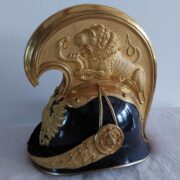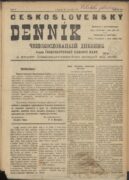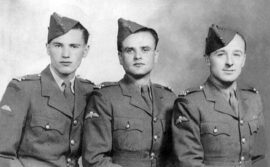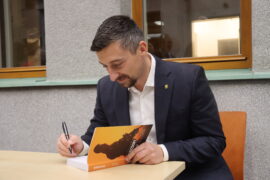
05 Austro-Hungarian Dragoon Officers Helmet, 1914
Fotogalerie


Dragoons of the Austro-Hungarian Army were one of the three main components of the cavalry. A characteristic element of their uniform from the middle of the 19th century was a helmet with a high crest (the original model was referred to as M 1850). In 1905, a new lighter helmet model with an oval diameter was introduced. Helmets did not indicate regiment affiliation, but at a glance it was possible to distinguish the categories of men, non-commissioned officers and officers. The latter wore helmets with the most lavish designs. The metal body was painted black. The scaly, gilded chin guard was decorated on both sides with headpieces with a lion head relief. Under the chin guard was a black lacquered leather strap with a buckle, allowing for fastening under the chin. A massive gilded coat of arms of the monarchy was fixed in the front. On the top of the helmet was a crest made of gilded metal. On both sides of the crest was a relief of a lion wrestling with a dragon (snake). Starting from the 16th century, the entire cavalry category was named after the dragons. The other metal elements connecting and lining the individual parts of the helmet were also gilded. After the outbreak of the First World War, they were repainted with a covering grey-blue colour because of unwanted glare or fitted with waxed canvas covers of the same colour.
Aktuálně

Československý deník sehrál v životě legionářů v Rusku velmi důležitou roli. Poprvé vyšel v prosinci 1917

Děkujeme za podporu pro válečné veterány. Sbírka DiGiMÁK vynesla 450 tisíc korun

Tak trochu zamrzlé spojení

Válečný veterán Petr Matouš pokřtil v Armádním muzeu Žižkov svou knihu. Patronkou je i ministryně obrany Jana Černochová








